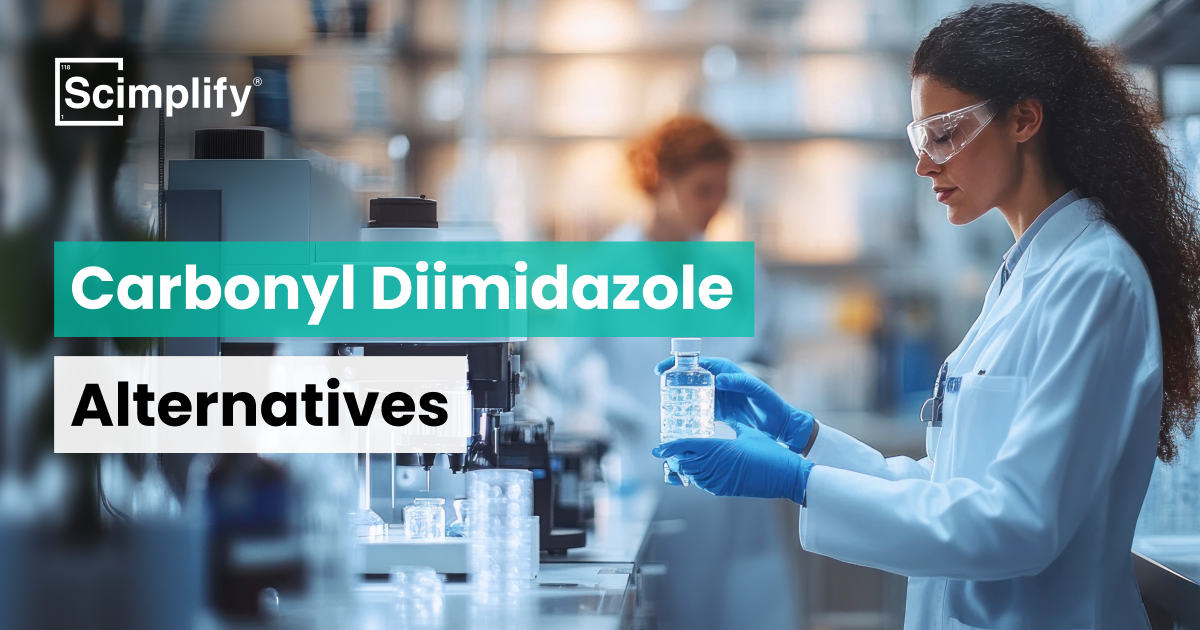Carbonyldiimidazole (CDI) is widely used as a dehydrating and activating agent, primarily in organic chemistry. Perhaps its most notable application is in the construction of amide, ester, carbamate, and urea linkages during peptide synthesis. CDI aids in the activation of carboxylic acids by creating a mechanism for nucleophilic attack, which generates imidazole and CO2 as byproducts, thus simplifying purification steps.
Alternatives of CDI (Carbonyldiimidazole)
DCC (Dicyclohexylcarbodiimide)
DCC remains one of the classical reagents used in the formation of amide and peptide bonds. It performs carboxylic acid activation by yielding O-acylureas, which react with amines and undergo peptide formation. It is known to improve the overall yield while decreasing the amount of racemization alongside HOBt or NHS.
Pros:
- Peptide synthesis with DCC is inexpensive and widely available.
- Provides strong coupling efficiency.
- Useful in non-aqueous solvents.
Cons:
- DCC also suffers from the production of solid dicyclohexylurea (DCU), a byproduct that poses significant difficulties for purification.
- On top of this, the central chiral carbon is prone to epimerization
- has poor compatibility with water-based systems
Explore manufacturing and buying options for Dicyclohexylcarbodiimide
EDC [1-Ethyl-3-(3-dimethylaminopropyl)carbodiimide]
As a water-soluble carbodiimide, EDC is advantageous in aqueous systems such as peptide synthesis and bioconjugation. In these systems, purification is problematic because of the removal of soluble by-products. EDC’s specific traits make it a better option.
Pros:
- Biological systems suitability
- Water-soluble and usable in biological systems
- Clean by-product (urea) with a simple removal process
Cons:
- High reactivity often needs supplements such as NHS, which is documented as less reactive than DCC or CDI.
- Skin and eye mild irritations are possible
- Mild skin and eye irritations are possible
Explore manufacturing and buying options for 1-Ethyl-3-(3-dimethylaminopropyl)carbodiimide
HATU (O-(7-Azabenzotriazol-1-yl)-N,N,N′,N′-tetramethyluronium
Leading the field of peptide coupling reagents, HATU is well known for its effectiveness and low racemization. It is widely used in solid-phase peptide synthesis (SPPS).
Pros
- Peptide synthesis does not result in much racemization
- Rapid reaction times
- Works effectively with hindered amines or acids
Cons:
- High cost
- Sensitive to moisture
- Requires careful waste disposal due to toxic by-products
TBTU / HBTU (Uronium-based reagents)
TBTU and HBTU are widely used coupling reagents for forming amide bonds in peptide synthesis. They’re efficient and compatible with both solid and solution-phase reactions.
Pros :
- High coupling efficiency
- Reduced racemization
- Practical in SPPS and solution-phase synthesis
Cons:
- More expensive than CDI or DCC
- Produces guanidinium by-products that can mess with purification
- Sensitive to moisture
SOCl₂ (Thionyl Chloride)
SOCl₂ is a potent chlorinating agent that transforms carboxylic acids into acyl chlorides, which can then easily react with amines or alcohols to create amides or esters.
Pros:
- Highly reactive with quick conversion
- Affordable and easy to find
- Commonly used in large-scale industrial synthesis
Cons:
- Corrosive and toxic; produces SO₂ and HCl fumes
- Needs strict anhydrous conditions
- Lacks selectivity can overreact or harm sensitive substrates
Explore manufacturing and buying options for SOCl₂ (Thionyl Chloride)
Triphosgene (Bis(trichloromethyl)carbonate)
CDI aids in the activation of carboxylic acids by creating a mechanism for nucleophilic attack, which generates imidazole and CO2 as byproducts, thus simplifying purification steps.
Triphosgene serves as a solid alternative to phosgene gas, utilized in the synthesis of carbamates and isocyanates. It’s more stable and safer to handle while maintaining similar reactivity.
Pros:
- A solid, safer substitute for phosgene
- Useful for synthesizing urea, isocyanates, and carbamates
- High conversion efficiency
Cons:
- Still toxic and corrosive
- Requires controlled environments and personal protective equipment (PPE)
- Produces HCl, which needs to be neutralized
Explore manufacturing and buying options for Triphosgene (Bis(trichloromethyl)carbonate)
CDMT (2-Chloro-4,6-dimethoxy-1,3,5-triazine)
CDMT is a triazine-based coupling agent ideal for forming amides and esters, particularly in aqueous or mixed solvent conditions. It’s known for its selectivity and environmental safety.
Pros:
- Stable and less hazardous
- Works well in aqueous or green solvent systems
- Low chance of racemization
Cons:
- Less reactive compared to uronium or carbodiimide reagents
- Limited availability in the market
- May require pre-activation steps in some situations
Explore manufacturing and buying options for CDMT (2-Chloro-4,6-dimethoxy-1,3,5-triazine)


